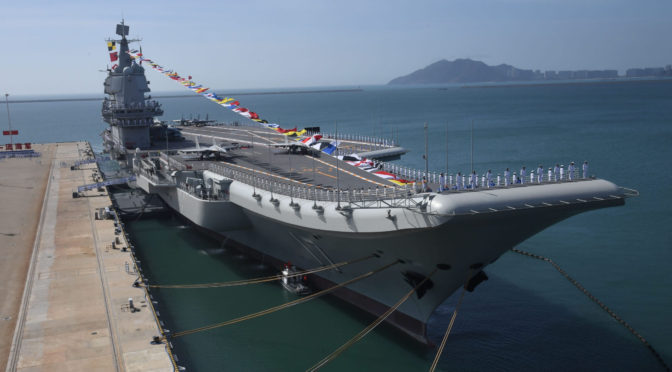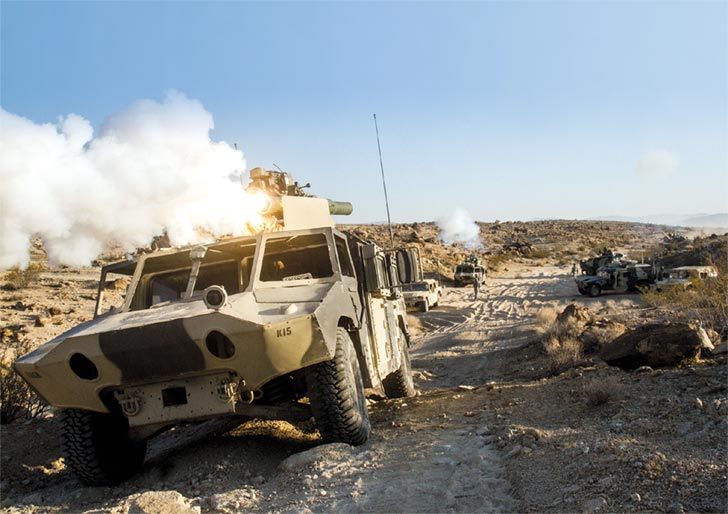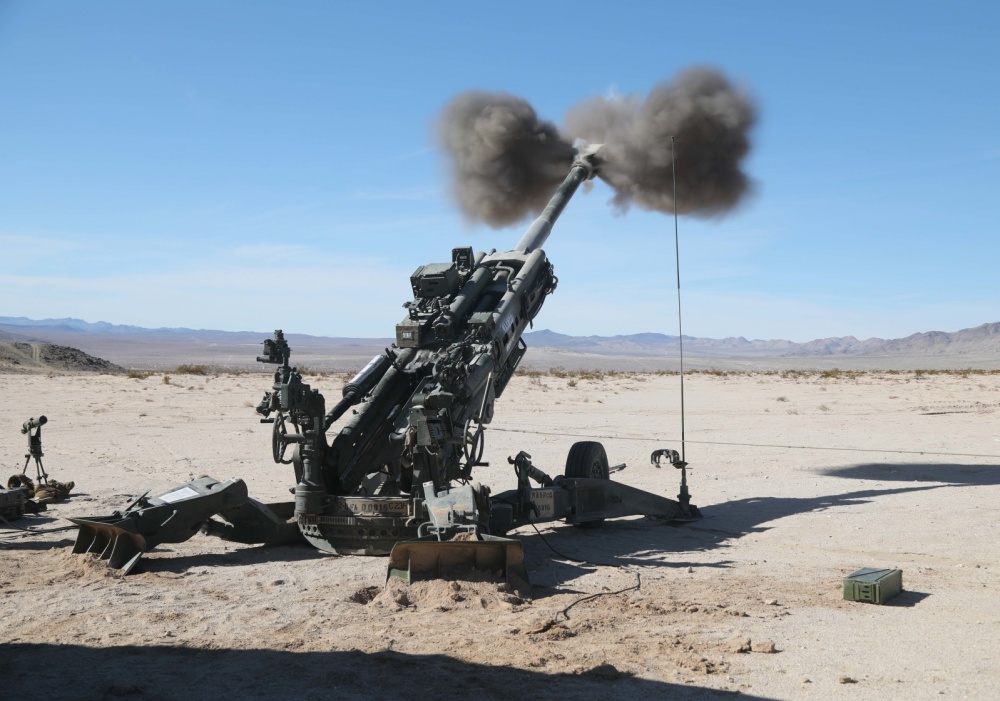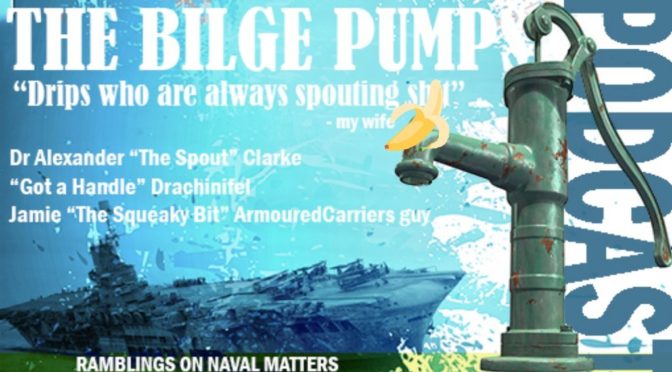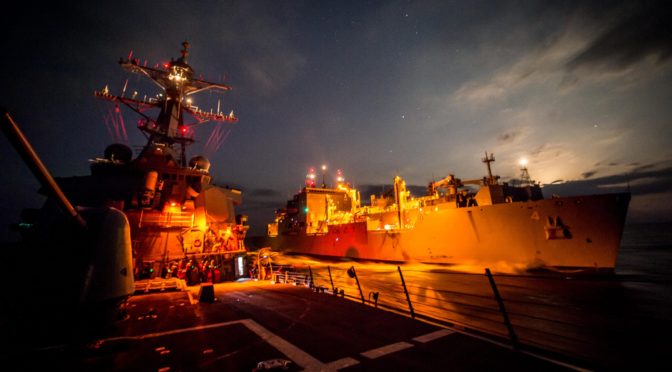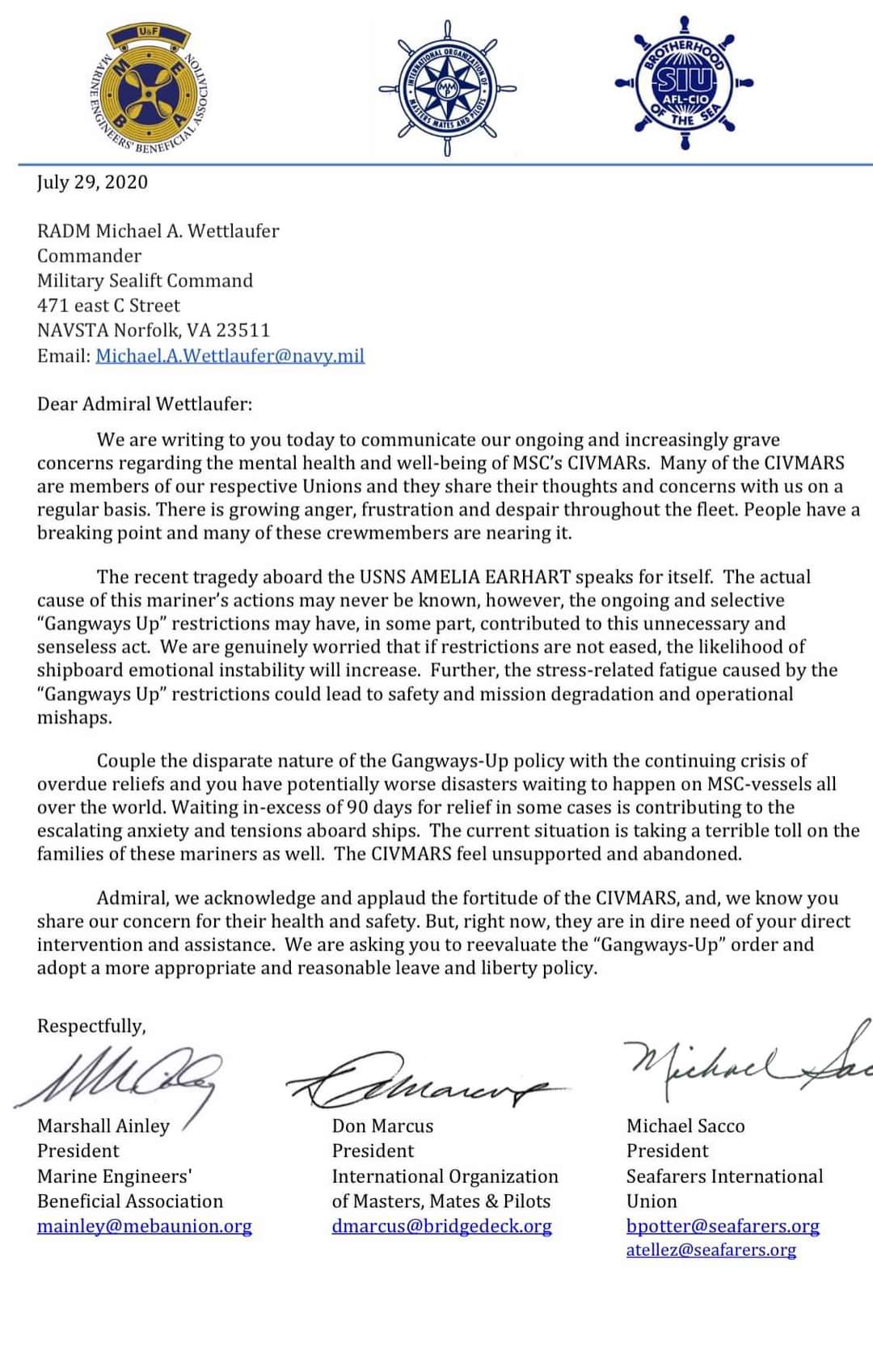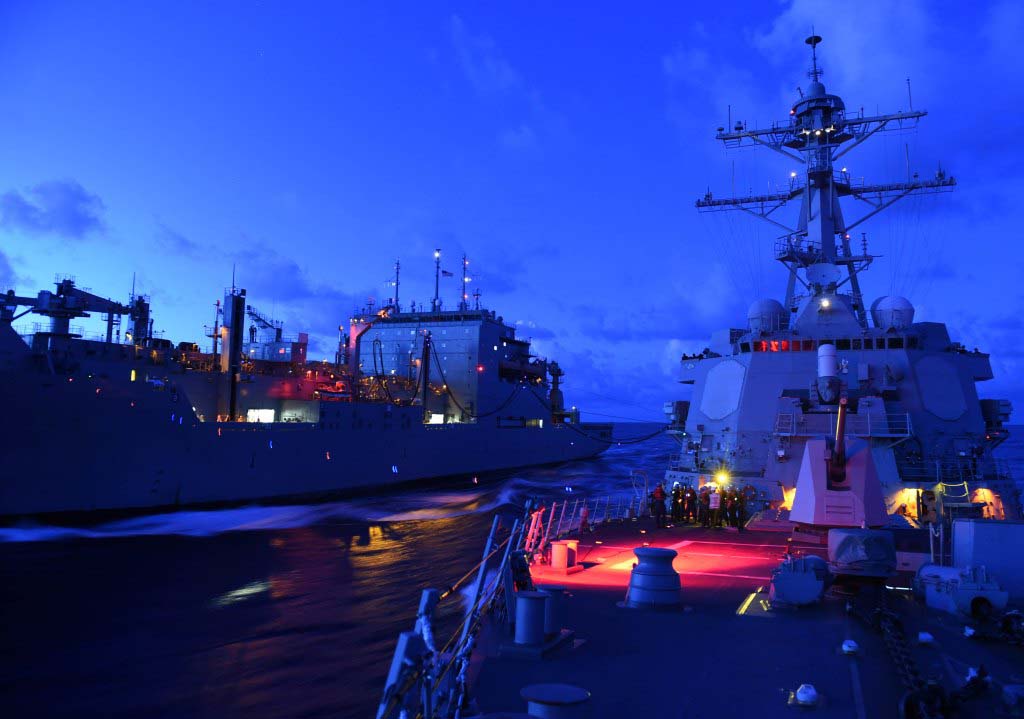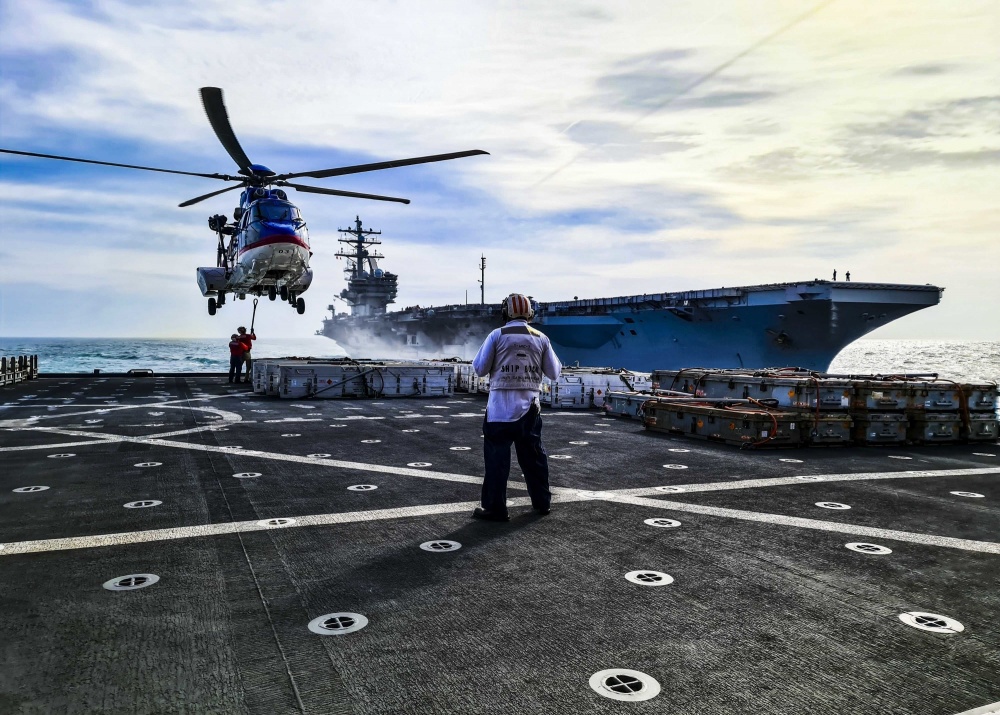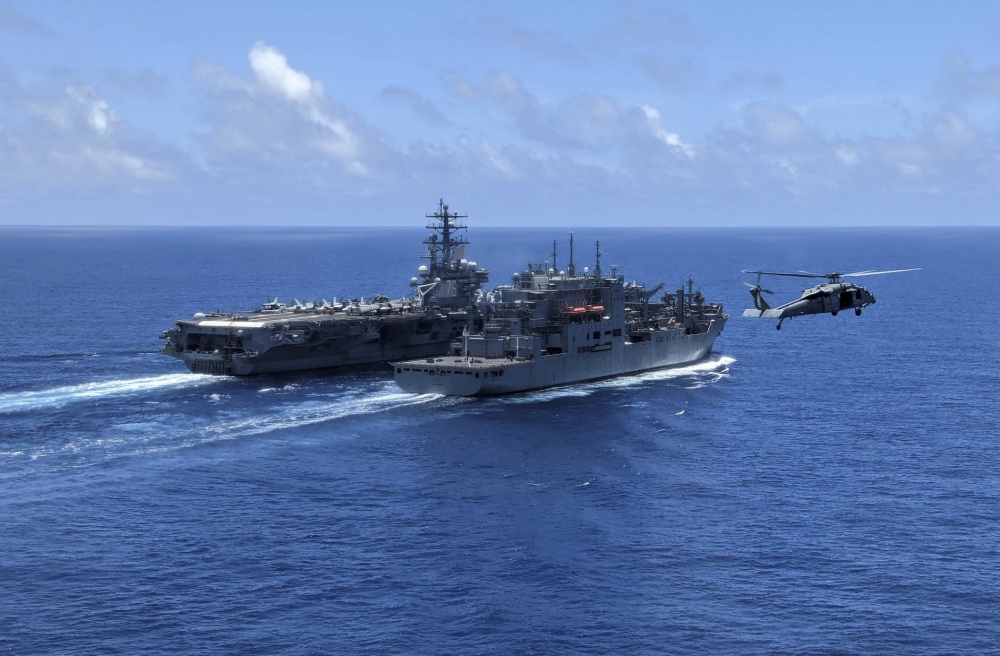Regional Strategies Topic Week
By Shang-su Wu
Introduction
Since the People’s Liberation Army Navy (PLAN) commissioned its second aircraft carrier, the possibility of utilizing these capital ships for coercive diplomacy is becoming more real. In China’s surrounding areas, Southeast Asia would be most suitable for “carrier diplomacy” regarding the proximity, the relatively weak defenses of the regional countries, and the major territorial disputes in the South China Sea. However, Southeast Asian countries, with their military modernizations and geopolitical circumstances, would not be merely hopeless either.
Chinese Carrier Group Capabilities
The main challenges coming from China’s aircraft carrier fleet come in the form of airpower and multi-domain survivability. The former refers to the shipboard J-15 fighters, but the number would be slightly lower than the maximal capacity of 24 and 32, respectively, for the Liaoning and Shandong, with several retained for self-defense.1 The matter of multi-domain survivability is derived from the major surface combatants escorting the aircraft carrier, particularly Type 055 cruisers, and how they could deny anti-ship threats, namely submarines, other surface ships, and anti-ship cruise missiles (ASCMs).2 As such, the kinetic countermeasures of Southeast Asian countries can be measured to an extent in whether their airpower or air defense capability can contest the J-15 fleet, and whether their sea denial capability can considerably threaten the carrier group itself.
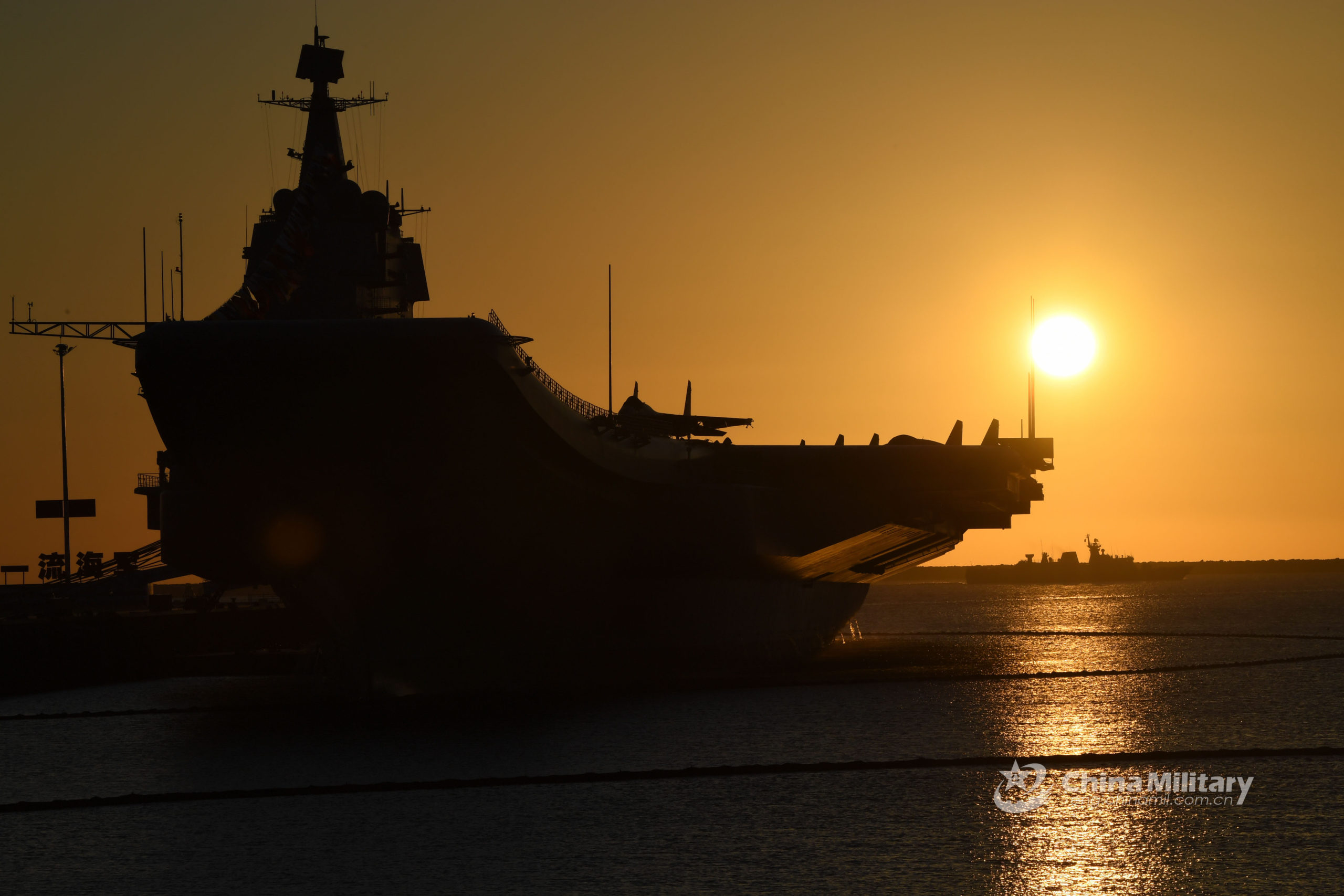
The Philippines
Geostrategically, the four Southeast Asian claimants bordering the South China Sea along with Indonesia would be the most likely targets for naval coercion due to their conflicting interests with China. Among them, the Philippines with its relative lack of anti-ship missiles and robust air defenses would be an ideal target, if the United States does not effectively support its ally.3 Although Manila recapitalized some of its fighter fleet from 2015 with a dozen Korean FA-50s and will introduce another dozen in the future, they are quantitatively, and perhaps qualitatively, inferior to the Chinese shipboard J-15 fighters.4 Although its two newly delivered frigates are armed with Korean C-STAR ASCMs, the platforms could be large targets for PLAN anti-ship firepower, and their subsonic anti-ship missiles may not penetrate the layered defenses of the Chinese aircraft carrier group.5 The only game-changer would be the upcoming BrahMos supersonic ASCMs arriving from India because their superior speed may allow for the penetration of carrier group air defenses.6 The BrahMos missiles will nevertheless be constrained with their limited numbers and over-the-horizon targeting capabilities of the Philippines, and where their kill chain could be preemptively attacked by the PLAN with precision-guided munitions or sabotage.
Brunei
Brunei has only four corvettes equipped with the French MM-40 ASCM, and without any fighters, would also be militarily suitable for coercion, but its geographic environment may not be suitable for naval coercion.7 Located between Malaysian territories, a Chinese naval deployment aimed at the kingdom will also draw close scrutiny from Malaysia and even Indonesia on the other side of Borneo. Based on their support for Southeast Asian regionalism and the rather neutral positions in the international community, it is unlikely for either Kuala Lumpur or Jakarta to welcome any coercion in their neighborhood. Unless Beijing is planning to take on or infuriate several countries simaultaneously, trying to coerce Brunei and other nearby Southeast Asian nations would be diplomatically unwise.
Malaysia
In the face of the Chinese aircraft carrier group, Malaysia is certainly inferior. Kuala Lumpur has purchased several modern fighters which would be equivalent to J-15s, but the MiG-29 squadrons are on their way to obsolescence and the serviceable numbers of other fighters are uncertain for the limited procurements of eight F-18Ds and 18 Su-30MKKs and the associated maintenance challenges.8 Malaysia also falls short in area air defense systems, as most surface-to-air missiles (SAMs) are portable for only point defense.9 Hence, the Chinese J-15s could likely achieve regional air superiority.
Kuala Lumpur has better potential in sea denial. The two French/Spanish Scorpene-class submarines are equipped with sub-launched French SM-39 Exocet ASCMs and Italian Black Shark torpedoes, and the F-18D and Su-30MKM aircraft are respectively armed with American AGM-84A Harpoons and Russian Kh-31A ASCMs, along with a range of surface vessels being platforms for MM-40 ASCMs.10 The submarine base bordering the South China Sea in Sabah would be convenient for deploying assets, and the combined platforms fielding ASCMs offer tactical potential for multi-axis salvo attacks which may overwhelm the PLAN’s layered defenses for its aircraft carrier.11 However, the uncertain serviceability and the challenge of joint operations between Malaysian naval vessels and air force fighters could inhibit options. A gambit between the Malaysian submarines and the Chinese aircraft carrier group is also unpredictable. The PLAN has improved its capability for anti-submarine warfare (ASW) for Type 052D destroyers and Type 055 cruisers which feature towed sonar arrays and new Z-18F ASW helicopters featuring larger capacity than the Z-9Cs helos.12 Due to the flotilla of only two submarines, there may be only one Malaysian submarine available, but the familiar operational environment and sub-launched ASCM offer advantages.
Indonesia
Despite not being a claimant in the South China Sea, the maritime disputes around the Natuna Islands make Indonesia a potential target for China to coercively deploy an aircraft carrier group.13 Jakarta’s airpower of 11 F-16A/Bs, 24 F-16C/Ds, five Su-27SK/SKMs, 11 SU-30MK/MK2 fighters, in addition to the likely deal of F-16Vs, would be more than the shipboard Chinese J-15s. But Indonesia’s logistical challenges, as reflected by frequent accidents, may undermine quantitative superiority.14
Indonesia’s sea denial is composed of five German and Korean Type-209 submarines armed with Black Shark torpedoes, and numerous surface platforms fielding various ASCMs, including MM-40s, Russian 3M55s, and Chinese C-705s and C-802s.15 Since a Chinese aircraft carrier group would likely not get too proximate to the archipelago in a tense situation (let alone pass through it) these Indonesian platforms may not be able conduct littoral ambushes using island cover. But they can operate in open seas. Jakarta may further face another challenge from a lack of military infrastructure nationwide, as Beijing may choose a location to pressure other than the Natuna Islands in the widely stretched archipelago, such as a future location near the new capital in East Kalimantan.16 However, Indonesia’s sizeable and expanding submarine fleet may constitute an independent and formidable underwater force for deterrence.17
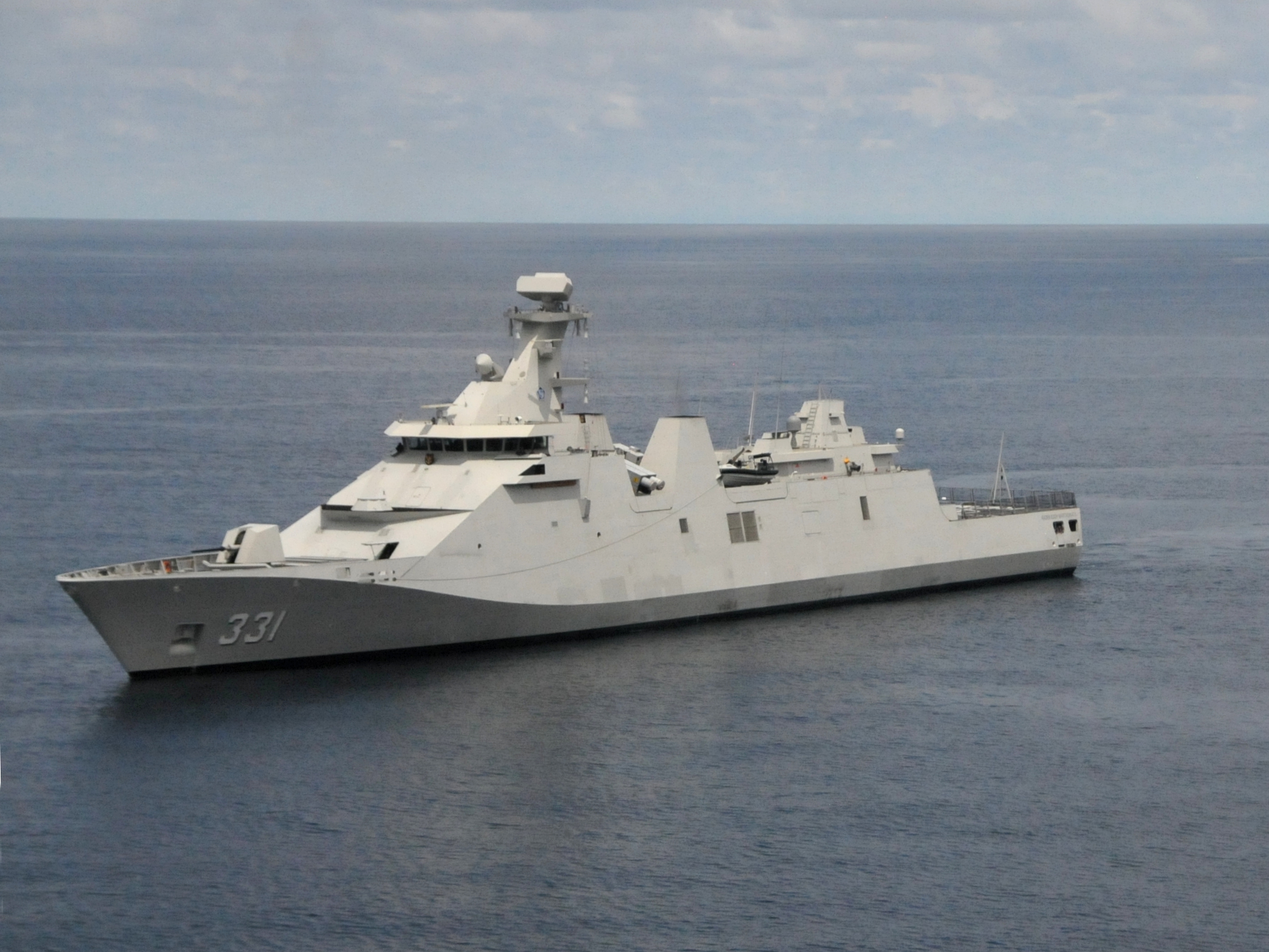
Vietnam
Vietnam is a mixed case for China to apply pressure via aircraft carrier. The adjacency allows the PLA and PLAN Air Forces to project airpower to almost the whole of Vietnam from various airbases in Guangxi, Hainan island, and even artificial islands in the South China Sea.18 As such, a Chinese aircraft carrier with its airpower could put additional pressure on Vietnam, but it may also be more exposed to the latter’s firepower.
Hanoi has procured a collection of Russian sea denial weapon systems, such as P-800 supersonic ASCMs onshore, six project-636 submarines with 3M-54 ASCMs, 53-65KEs, and TEST-71 torpedoes, P-15s and 3M24E ASCMs from several frigates and fast attack craft, in addition to airborne Kh-31A ASCMs launched by Su-30 MK2 aircraft.19 Those assets and munitions could put a Chinese aircraft carrier in a dilemma: too close to be exposed to attack and a significant risk of damaging or losing their national pride, or too far so that shipboard J-15s can hardly contribute much beyond land-based Chinese airpower. The risk of losing these icons of national pride may make Beijing cautious in aggressively deploying its aircraft carriers against Hanoi.
Cambodia
Beyond these five Southeast Asian countries, the rest represent distinct scenarios. Without ASCMs, fighters, or other considerable sea denial capabilities, Cambodia would be a militarily attractive target for naval coercion.20 The location in the Gulf of Thailand away from the South China Sea, nevertheless, suggests the low geopolitical value of Cambodia to sea lines of communication (SLOCs). At the two ends of the entrance to the Gulf of Thailand are Vietnam and Thailand, and sending an aircraft carrier group into the gulf would affect relations with these states more than with Cambodia. Finally, Phnom Penh’s friendship with Beijing, especially the former’s dependence on the latter’s investment, would make it the least likely nation in the region for the PLAN to coerce compared to the economic pressures available.
Thailand
Thailand’s coastlines, either on the Gulf or the Indian Ocean, may not be suitable for the Chinese aircraft carrier group to operate in. As previously mentioned, the Gulf is rather irrelevant to China’s maritime interest in the SLOCs, and the force presence near the Thai coastline on the Indian Ocean is too remote to Bangkok. As for air defense, the two Swedish Saab-340 airborne early warning (AEW) aircraft would help fighter fleets of 11 JAS-39C/D and 53 F-16A/B fighters, together with some older but upgraded F-5E/F fighters, contest the Chinese J-15s.
Bangkok also maintains a range of platforms fielding ASCMs in the air and surface, such as Swedish RBS-15F from the JAS-39 fighters, RGM-84s and C-802s from different frigates and corvettes, in addition to its DTI-1G artillery rockets which could also conduct sea denial missions, particularly at the entrance of the Gulf.21 Furthermore, an imminent S-26T submarine from China with C-708 ASCMs and Yu-7 torpedoes would strengthen Thailand’s deterrence as well.22
Thailand’s diverse anti-ship firepower in the Gulf may lend itself to deterrence against PLAN carrier groups because of multi-directional threats that could be made real with rather short warning times. If Beijing chooses to deploy the aircraft carrier out of the Gulf, the coercive pressure placed on Bangkok would be lower due to distance and shift toward other nations.
Singapore
Surrounded by Malaysia and Indonesia, Singapore would also be geopolitically unsuitable for targeted naval coercion, and the disruption of the Singapore Strait will create consequences going far beyond the region. Militarily, the city-state’s fighter fleets of 60 F-16C/Ds and 40 F-15SGs backed by four G-550 AEW aircraft are stronger than the J-15s from either the Liaoning, Shandong, or even both combined. Singapore has also invested in sea denial capabilities, comprised of four ex-Swedish submarines, two Sjoormen and two Västergötland with air-independent propulsion, the RGM-84 and AGM-84 from surface vessels, and Fokker-50 maritime patrol aircraft, AGM-158s from fighters, plus HIMARS guided rockets onshore.23 The four submarines will soon be replaced with four, more modern Type-218s from Germany.24 Although PLAN major surface combatants could intercept subsonic Harpoon missiles, the Singaporean fighters supported by four A-330 aerial refueling aircraft could pose a formidable threat to the J-15 squadrons and contest coercion or outright attack.
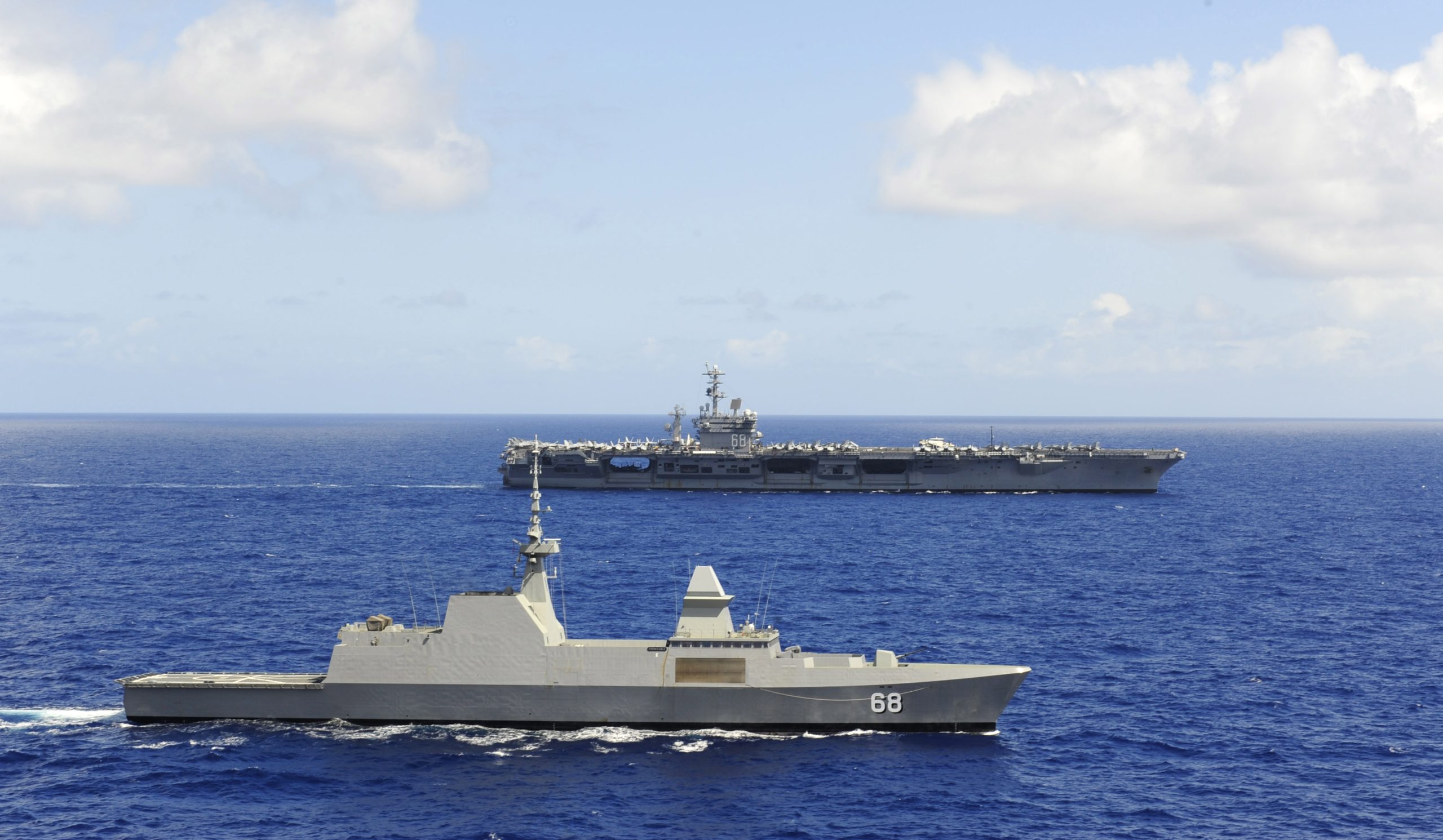
Myanmar
The long bilateral borders and the endless isurgency present a range of alternatives for China to sending an aircraft carrier group to coerce Myanmar, not to mention their economic ties. If Beijing still chooses the naval option, Naypyidaw is not completely inferior. Although Myanmar only has the sea denial capability of subsonic Chinese ASCMs on surface vessels which could likely not penetrate the PLAN’s layered defenses, its fleet of 32 MiG-29B/SM fighters along with 30+ inferior J-7s and some JF-17s, plus several Russian S-125, 2K12, and Chinese KS-1 surface-to-air missile (SAM) systems, could make for a match with the J-15s.25 Geostrategically, a Chinese aircraft carrier group sailing into the Indian Ocean would also alarm India, and the Andaman and Nicobar tri-service command can facilitate Indian military deployments near Myanmar.26 The PLAN would not operate freely in the Andaman Sea.
Conclusion
In terms of military and geostrategy alone, Beijing already faces some constraints and countervailing forces on applying coercive aircraft carrier diplomacy to Southeast Asia. The most appropriate target would be the Philippines, followed by Malaysia and Indonesia, due to their territorial disputes with China and their relatively inferior military capabilities, but they still have some means to deter a PLAN aircraft carrier group. These aircraft carriers do indeed contribute to Beijing’s image of a rising military superpower, but their operational applications may not be as overwhelming as the propaganda describes.
It must be noted that all Southeast Asian countries carefully handle their relations with China and strenuously work to prevent any occasion for the latter to pursue military options. However, if the strong choose to do as they please, the weak will not merely suffer what they must.
Shang-su Wu is a research fellow at the S. Rajaratnam School of International Studies (RSIS), Nanyang Technological University in Singapore.
References
1. Sebastien Roblin, “Here’s Everything We Know About China’s Domestically Built Shandong Aircraft Carrier,” the National Interest, 27 FEBRUARY 2020, https://nationalinterest.org/blog/buzz/heres-everything-we-know-about-chinas-domestically-built-shandong-aircraft-carrier-127607
2. International Institute for Strategic Studies (IISS), Military Balance 2020 (London: IISS, 2020), 262.
3. IISS, Military Balance 2020, 305.
4. Francis Wakefield, “PH to acquire 12 more FA-50 light fighter jets,” Manila Bulletin, 9 JUNE 2018, https://news.mb.com.ph/2018/06/07/ph-to-acquire-12-more-fa-50-light-fighter-jets/
5. Martin Manaranche, “Future Philippine Navy Frigate BRP ‘Jose Rizal’ Sails Home for Commissioning,” Naval News, 18 MAY 2020, https://www.navalnews.com/naval-news/2020/05/future-philippine-navy-frigate-brp-jose-rizal-sails-home-for-commissioning/
6. Masao Dahlgren, “Philippines to Order BrahMos Missile,” Missile Threat, 20 DECEMBER 2019, https://missilethreat.csis.org/philippines-to-order-brahmos-missile/
7. IISS, Military Balance 2020, 256-257.
8. IISS, 293; “Malaysia air force says low maintenance rate of fighter jets partly due to lack of operating funds,” the Strait Times, 3 AUGUST 2018, https://www.straitstimes.com/asia/se-asia/malaysia-air-force-says-low-maintenance-rate-of-fighter-jets-partly-due-to-lack-of
9. IISS, 292-293
10. IISS, 293.
11. IISS, 293; “Malaysia Submarine Capabilities,” Nuclear Threat Initiative (NTI), 16 OCTOBER 2019, https://www.nti.org/analysis/articles/malaysia-submarine-capabilities/
12. IISS, 236; “Z-18 Medium transport helicopter,” Military Today, http://www.military-today.com/helicopters/z18.htm
13. Fransiska Nangoy, Wilda Asmarini, Stanley Widianto, and Gabriel Crossley, “Indonesia’s president visits island in waters disputed by China,” Reuters, 8 JANUARY 2020, https://www.reuters.com/article/us-indonesia-china-southchinasea-idUSKBN1Z710N
14. Yulius Yoma, “C-130 crashes in Indonesia, 6th similar accident in 2016,” Aerotime, 20 DECEMBER 2016, https://www.aerotime.aero/yulius.yoma/16039-c-130-crashes-in-indonesia-6th-similar-accident-in-2016; IISS, 278; “F-16 Indonesia,” Lockheed Martin, 2020, https://www.lockheedmartin.com/en-us/products/f-16/f-16-indonesia.html; Heru Andriyanto and Yeremia Sukoyo, “Indonesia’s Defense Modernization Gains Momentum After Two Air Crashes in Nine Days,” Jakarta Globe, 15 JUNE 2020, https://jakartaglobe.id/news/indonesias-defense-modernization-gains-momentum-after-two-air-crashes-in-nine-days
15. IISS, 277; “Indonesia Submarine Capabilities,” NTI, 17 OCTOBER 2019, https://www.nti.org/analysis/articles/indonesia-submarine-capabilities/
16. Marchio Irfan Gorbiano, “’Indonesia’s new capital city will be very special,’ Tony Blair says,” the Jakarta Post, 29 FEBRUARY 2020, https://www.thejakartapost.com/news/2020/02/29/indonesias-new-capital-city-will-be-very-special-tony-blair-says.html; Evan Laksmana, “The military and strategic implications of Indonesia’s new capital,” the Strategist, 6 NOVEMBER 2019, https://www.aspistrategist.org.au/the-military-and-strategic-implications-of-indonesias-new-capital/; Beritasatu, “Indonesia Set to Have Four New Military Bases,” Jakarta Globe, 5 OCTOBER 2019, https://jakartaglobe.id/news/indonesia-set-to-have-four-new-military-bases/
17. “Indonesia Submarine Capabilities,” NTI.
18. Ben Werner, “New Air Bases, Baby Cabbage Key to Chinese Long-Term Claims in South China Sea,” USNI News, 3 JUNE 2020, https://news.usni.org/2020/06/03/new-air-bases-baby-cabbage-key-to-chinese-long-term-claims-on-south-china-sea
19. IISS, 319-320.
20. IISS, 258.
21. IISS, 315-316.
22. SIPRI.
23. IISS, 307-308.
24. Lim Min Zhang, “Invincible, first of Singapore’s biggest and most advanced submarines, launches in Germany,” the Straits Times, 18 FEBRUERY 2019, https://www.straitstimes.com/singapore/singapores-first-type-218sg-submarine-launched-in-germany-named-invincible
25. IISS, 296-297.
26. Rahul Singh, “Andaman defence commander gets power over all three services,” Hindustan Times, 12 MAY 2018, https://www.hindustantimes.com/india-news/andaman-defence-commander-gets-power-over-all-three-services/story-LLhvEAs1CSF9nO2sVrTmBK.html
Featured Image: Chinese aircraft carrier Shandong berthed at a naval port in Sanya in December 2019. (Photo via eng.chinamil.com.cn, photo by Feng Kaixuan)

